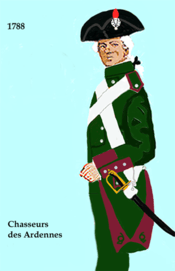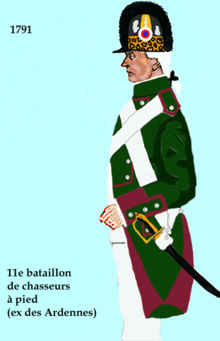Chasseurs des Ardennes
The Chasseurs des Ardennes was a light infantry battalion of the French Royal Army which was created just before the French Revolution. The battalion would see light service during the initial stages of the conflict in the Eastern Pyrenees, but its lineage ended in 1794 after it amalgamated with two volunteer battalions to form a demi-brigade. The battalion's successor, the 86éme Régiment d'Infanterie continued to serve in the modern French Army until it was disbanded in 1963.
| Chasseurs du Gèvaudan 11éme Bataillon de Chassers (Gèvaudan) | |
|---|---|
 Regimental uniform after formation in 1788. | |
| Active | 1788–1794 |
| Country | |
| Allegiance | King of France French Nation |
| Branch | |
| Type | Chasseurs à Pied |
| Size | Battalion |
| Part of | Army of the Alps Army of the Rhine |
| Headquarters | Montauban |
Formation
The Chasseurs des Ardennes was formed in and was to recruit exclusively from troops of the Ardennes region of France and Austrian Netherlands in 1788. The battalion was formed in Montauban from the four infantry companies of the Chasseurs à Cheval des Ardennes, where it established its headquarters. The battalion was placed 11th in precedence of the chasseurs, after the Chasseurs du Gèvaudan and before the Chasseurs du Roussillon.[1][2]

The regiment's first uniform consisted of; black tricone (officers in bicorne), dark green collar, dark green turnbacks, dark green jacket, dark green breeches, dark green gaiters, black boots, dark green pockets, dark green pockets, dark green cuff flaps, crimson cuffs, and white buttons.[1][3][4]
In the later part of 1788, the battalion moved to Monaco, and from there it moved to Antibes in 1790.[2]
Revolution
On 1 April 1791, provisional regulations were announced following the initial stages of the French Revolution, and the regiment renamed as the 11éme Bataillon de Chasseurs (Ardennes), but they continued to be known as their former title until 1792. In addition to the new title, the regiment adopted a new uniform; peak casque, with stiff black horsehair crest and mock leopard skin turban helmet, dark green collar, dark green turnbacks, dark green jacket, dark green breeches, dark green gaiters, black boots, dark green pockets, dark green pockets, dark green cuff flaps, crimson cuffs, and white buttons.[1][3][4]
War of the First Coalition
In September 1791, the battalion moved to Sorgues form Antibes, where it had been garrisoned since 1790. The battalion remained in Sorgues during the Massacres of La Glacière. In 1792, the battalion joined the Army of the Alps and subsequently moved to Barrault, but in the end of 1793 joined Army of the Rhine where it remained until disbandment in 1794.[2]
The years following the Revolution saw great changes for the French Army: the old royalist infantry regiments were to serve as the stiffening for the tens of thousands of new volunteers who answered the patriotic Levée en masse. In the First Amalgamation of 1794, each old royalist battalion was put together with two new volunteers battalions to become new Demi-Brigade de Bataille or Demi-Brigade of Battle. Therefore, on 24 February 1795, the battalion amalgamated with the Battalion of Chasseurs of the Cher and Battalion of Chasseurs of the Meuse to form the 11éme Demi-Brigade Légère, thus ending the royalist lineage and traditions.[1][2]
Commanding Officers
Commanding officers of the battalion were:[2]
- 1788–1791 Charles Joseph de Losse de Bayac
- 1791–1792 Gabriel François Louis, Marquis de Becdelièvre
- 1792–1792 François du Contant de La Molette de Fontenilles
- 1792–1793 N. Garnier
- 1793–1794 Paul Dominique Chabannacy de Marnas
Footnotes
- Susane, Volume I, pp. 311, 313–314, 364, 369, 399, 404.
- Susane, Volume VII, pp. 388–389.
- Lienhart & Humbet, pp. 57–58.
- Smith, Uniforms of the Napoleonic Wars, p. 42–47.
References
- Louis Susane, Historie de l'Ancienne Infanterie Français, Volume I, 1849 Naval and Polytechnical Military Library of Paris, Paris, France.
- Louis Susane, Historie de l'Ancienne Infanterie Français, Volume VII, 1853 Naval and Polytechnical Military Library of Paris, Paris, France.
- Dr. Constance Lienhart & Réne Humbert, The Uniforms of French Armies 1690–1894; Volume 3: The Infantry, Originally published in 1906, re-printed in 2020, Zanica, Italy. ISBN 978-8893275255.
- Digby Smith & Jeremy Black, An Illustrated Encyclopedia of Uniforms of the Napoleonic Wars, 2015 Lorenz Books, London, United Kingdom. ISBN 978-0-7548-1571-6.